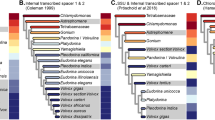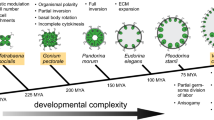Abstract
Chlamydomonas reinhardtii, Volvox carteri, and their relatives in the family Volvocaceae provide an excellent opportunity for studying how multicellular organisms with differentiated cell types evolved from unicellular ancestors. While C. reinhardtii is unicellular, V. carteri is multicellular with two cell types, one of which resembles C. reinhardtii cytologically but is terminally differentiated. Maintenance of this “somatic cell” fate is controlled by RegA, a putative transcription factor. We recently showed that RegA shares a conserved region with several predicted V. carteri and C. reinhardtii proteins and that this region, the VARL domain, is likely to include a DNA-binding SAND domain. As the next step toward understanding the evolutionary origins of the regA gene, we analyzed the genome sequences of C. reinhardtii and V. carteri to identify additional genes with the potential to encode VARL domain proteins. Here we report that the VARL gene family, which consists of 12 members in C. reinhardtii and 14 in V. carteri, has experienced a complex evolutionary history in which members of the family have been both gained and lost over time, although several pairs of potentially orthologous genes can still be identified. We find that regA is part of a tandem array of four VARL genes in V. carteri but that a similar array is absent in C. reinhardtii. Most importantly, our phylogenetic analysis suggests that a proto-regA gene was present in a common unicellular ancestor of V. carteri and C. reinhardtii and that this gene was lost in the latter lineage.





Similar content being viewed by others
References
Abascal F, Zardoya R, Posada D (2005) ProtTest: selection of best-fit models of protein evolution. Bioinformatics 21:2104–2105
Baldauf SL (2003) The deep roots of eukaryotes. Science 300:1703–1706
Bottomley MJ, Collard MW, Huggenvik JI, Liu Z, Gibson TJ, Sattler M (2001) The SAND domain structure defines a novel DNA–binding fold in transcriptional regulation. Nat Struct Biol 8:626–633
Brooke NM, Holland PW (2003) The evolution of multicellularity and early animal genomes. Curr Opin Genet Dev 13:599–603
Carles CC, Choffnes-Inada D, Reville K, Lertpiriyapong K, Fletcher JC (2005) ULTRAPETALA1 encodes a SAND domain putative transcriptional regulator that controls shoot and floral meristem activity in Arabidopsis. Development 132:897–911
Carroll SB (2001) Chance and necessity: the evolution of morphological complexity and diversity. Nature 409:1102–1109
Carroll SB (2005) Endless forms most beautiful: the new science of evo devo and the making of the animal kingdom. W. W. Norton, New York, NY
Chenna R, Sugawara H, Koike T, Lopez R, Gibson TJ, Higgins DG, Thompson JD (2003) Multiple sequence alignment with the Clustal series of programs. Nucleic Acids Res 31:3497–3500
Chomczynski P, Mackey K (1995) Modification of the TRI reagent procedure for isolation of RNA from polysaccharide- and proteoglycan-rich sources. Biotechniques 19:942–945
Coleman AW (1999) Phylogenetic analysis of “Volvocacae” for comparative genetic studies. Proc Natl Acad Sci USA 96:13892–13897
Doron-Faigenboim A, Stern A, Mayrose I, Bacharach E, Pupko T (2005) Selecton: a server for detecting evolutionary forces at a single amino-acid site. Bioinformatics 21:2101–2103
Duboule D (1994) Guidebook to the homeobox genes. Oxford University Press, New York, NY
Duncan L, Nishii I, Howard A, Kirk D, Miller SM (2006) Orthologs and paralogs of regA, a master cell-type regulatory gene in Volvox carteri. Curr Genet 50:61–72
Fabry S, Jacobsen A, Huber H, Palme K, Schmitt R (1993) Structure, expression, and phylogenetic relationships of a family of ypt genes encoding small G-proteins in the green alga Volvox carteri. Curr Genet 24:229–240
Garcia-Fernandez J (2005) The genesis and evolution of homeobox gene clusters. Nat Rev Genet 6:881–892
Guindon S, Gascuel O (2003) A simple, fast, and accurate algorithm to estimate large phylogenies by maximum likelihood. Syst Biol 52:696–704
Hall BG (2004) Phylogenetic trees made easy. Sinauer Associates, Sunderland, MA
Harper JF, Huson KS, Kirk DL (1987) Use of repetitive sequences to identify DNA polymorphisms linked to regA, a developmentally important locus in Volvox. Genes Dev 1:573–584
Harper JF, Mages W (1988) Organization and structure of Volvox beta-tubulin genes. Mol Gen Genet 213:315–324
Harris EH (1989) The Chlamydomonas sourcebook: a comprehensive guide to biology and laboratory use. Academic Press, San Diego, CA
Huskey RJ, Griffin BE (1979) Genetic control of somatic cell differentiation in Volvox analysis of somatic regenerator mutants. Dev Biol 72:226–235
Karlin S, Brocchieri L, Bergman A, Mrazek J, Gentles AJ (2002) Amino acid runs in eukaryotic proteomes and disease associations. Proc Natl Acad Sci USA 99:333–338
King N, Hittinger CT, Carroll SB (2003) Evolution of key cell signaling and adhesion protein families predates animal origins. Science 301:361–363
Kirk D (1998) Volvox: molecular-genetic origins of multicellularity and cellular differentiation. Cambridge University Press, Cambridge, UK
Kirk DL (2005) A twelve–step program for evolving multicellularity and a division of labor. Bioessays 27:299–310
Kirk DL, Kirk MM (1983) Protein synthetic patterns during the asexual life cycle of Volvox carteri. Dev Biol 96:493–506
Kirk MM, Stark K, Miller SM, Muller W, Taillon BE, Gruber H, Schmitt R, Kirk DL (1999) regA, a Volvox gene that plays a central role in germ–soma differentiation, encodes a novel regulatory protein. Development 126:639–647
Knoll AH, Carroll SB (1999) Early animal evolution: emerging views from comparative biology and geology. Science 284:2129–2137
Kropat J, von Gromoff ED, Muller FW, Beck CF (1995) Heat shock and light activation of a Chlamydomonas HSP70 gene are mediated by independent regulatory pathways. Mol Gen Genet 248:727–734
Leache AD, Reeder TW (2002) Molecular systematics of the eastern fence lizard (Sceloporus undulatus): a comparison of parsimony, likelihood, and bayesian approaches. Syst Biol 51:44–68
Lewis LA, McCourt RM (2004) Green algae and the origin of land plants. Am J Bot 91:1535–1556
Liss M, Kirk DL, Beyser K, Fabry S (1997) Intron sequences provide a tool for high-resolution phylogenetic analysis of volvocine algae. Curr Genet 31:214–227
Meissner M, Stark K, Cresnar B, Kirk DL, Schmitt R (1999) Volvox germline-specific genes that are putative targets of RegA repression encode chloroplast proteins. Curr Genet 36:363–370
Nedelcu AM, Michod RE (2006) The evolutionary origin of an altruistic gene. Mol Biol Evol 23:1460–1464
Nozaki H (2003) Origin and evolution of the genera Pleodorina and Volvox (Volvocales). Biologia (Bratislava) 58:425–431
Ronquist F, Huelsenbeck JP (2003) MrBayes 3: Bayesian phylogenetic inference under mixed models. Bioinformatics 19:1572–1574
Starr RC (1969) Structure, reproduction and differentiation in Volvox carteri f. nagariensis IYENGAR, strains HK9 and HK10. Arch Protistenk 111:204–222
Starr RC (1970) Control of differentiation in Volvox. Symp Soc Dev Biol 29:59–100
Surdo PL, Bottomley MJ, Sattler M, Scheffzek K (2003) Crystal structure and nuclear magnetic resonance analyses of the SAND domain from glucocorticoid modulatory element binding protein-1 reveals deoxyribonucleic acid and zinc binding regions. Mol Endocrinol 17:1283–1295
Swofford D (2002) PAUP*: phylogenetic analysis using parsimony (*and other methods). Sinauer Associates, Sunderland, MA
Tam LW, Kirk DL (1991) The program for cellular differentiation in Volvox carteri as revealed by molecular analysis of development in a gonidialess/somatic regenerator mutant. Development 112:571–580
Whelan S, Goldman N (2001) A general empirical model of protein evolution derived from multiple protein families using a maximum-likelihood approach. Mol Biol Evol 18:691–699
Wojciak JM, Clubb RT (2001) Finding the function buried in SAND. Nat Struct Biol 8:568–570
Acknowledgments
L.D. thanks William Snell and Steve McKnight for their assistance. We thank Tamra Mendelson and Kevin Omland for the use of their computers, Scott Nichols and Kevin Omland for helpful advice, and Tim Ford for hel** to assemble some of the figures. Support to A. Harryman and A. Howard was provided by an NIGMS Initiative for Minority Student Development Grant (R25-GM55036) and Procter and Gamble. S.B. was supported by National Institutes of Health (NIH) National Research Service (NRSA) Award GM 08663 to the Minority Access to Research Careers (MARC) Undergraduate Student Training in Academic Research (U*STAR) Program at UMBC. This work was supported by Grant IBN-0444896 from the National Science Foundation to S.M.M. The C. reinhardtii and V. carteri genome sequencing work was performed by the Joint Genome Institute (http://www.jgi.doe.gov/) under the auspices of the U.S. Department of Energy’s Office of Science, Biological and Environmental Research Program and the University of California, Lawrence Livermore National Laboratory under Contract No. W-7405-ENG-48, Lawrence Berkeley National Laboratory under Contract No. DE-AC03-76SF00098, and Los Alamos National Laboratory under Contract No. W-7405-ENG-36 and was provided for use in this publication only.
Author information
Authors and Affiliations
Corresponding author
Additional information
[Reviewing Editor: Dr. Manyuan Long]
Electronic Supplementary Material
Rights and permissions
About this article
Cite this article
Duncan, L., Nishii, I., Harryman, A. et al. The VARL Gene Family and the Evolutionary Origins of the Master Cell-Type Regulatory Gene, regA, in Volvox carteri . J Mol Evol 65, 1–11 (2007). https://doi.org/10.1007/s00239-006-0225-5
Received:
Accepted:
Published:
Issue Date:
DOI: https://doi.org/10.1007/s00239-006-0225-5




